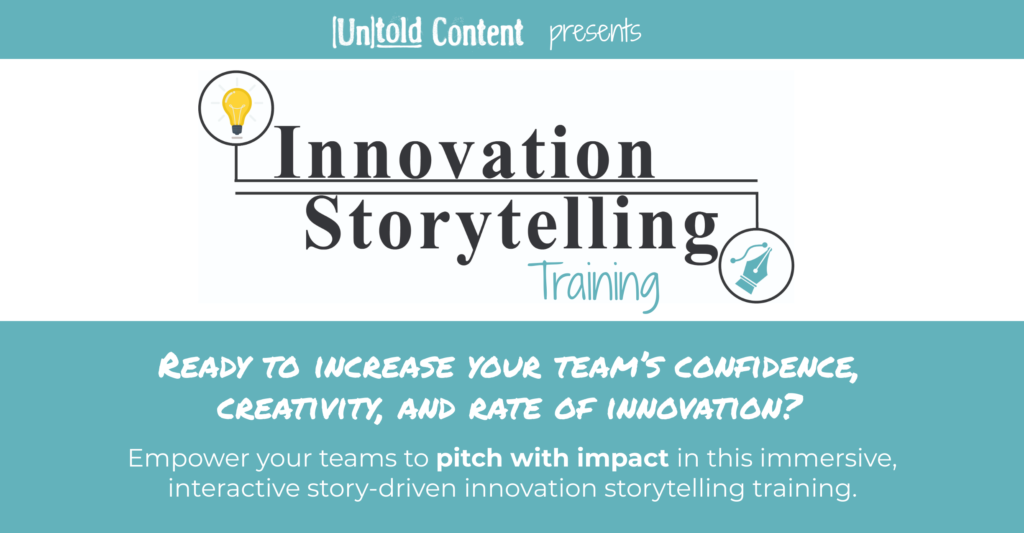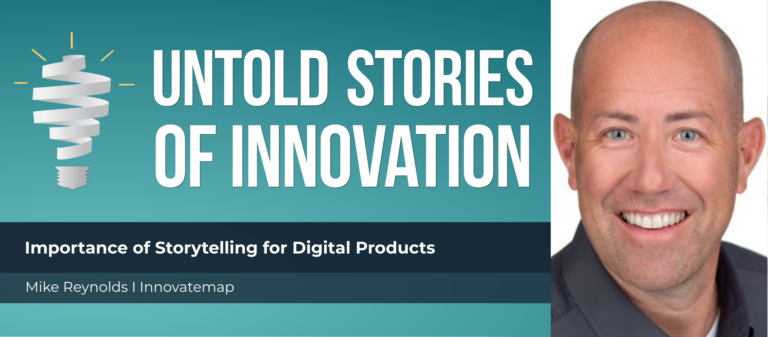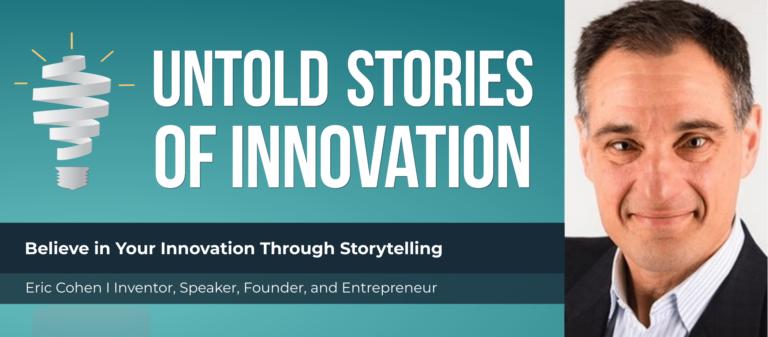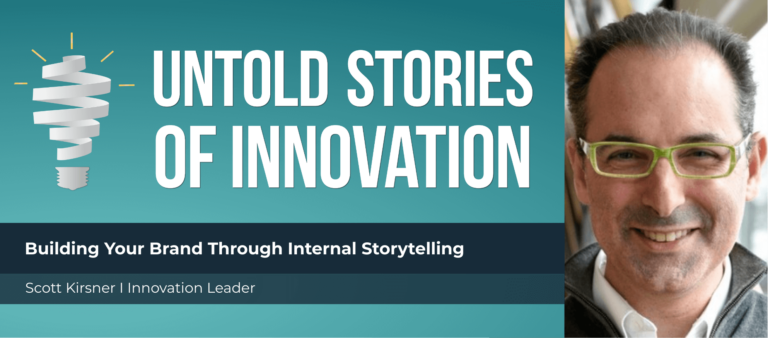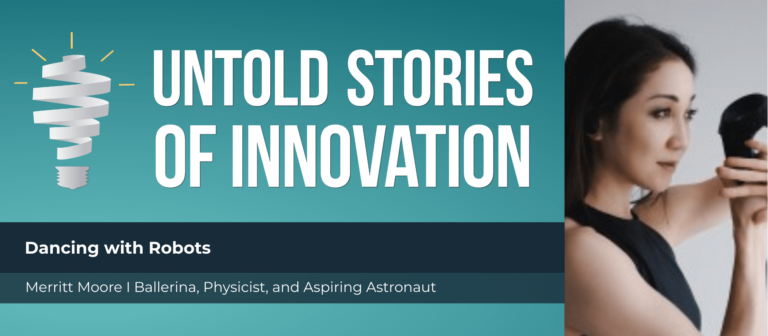Healthcare Communication Solutions with Michael Docktor of Dock Health
Healthcare Communication Solutions - Untold Stories of Innovation
“To take an idea from concept to reality, storytelling is essential.” —Michael Docktor, co-founder and CEO of Dock Health
From today’s episode you’ll learn:
Why do stories matter to the innovation process? What values can be instilled in innovators who share stories? How do innovation leaders inspire creators to tell and share their success and failure stories?
We speak with Michael Docktor of Dock Health about his experiences as a healthcare provider and innovator. Michael’s innovation story began with a simple question: when we have apps to track our grocery lists and our emails, why shouldn’t we have the same for healthcare? By blending tech discoveries with clinical experience, Michael set out to improve communication among care teams with a cutting-edge task management platform.
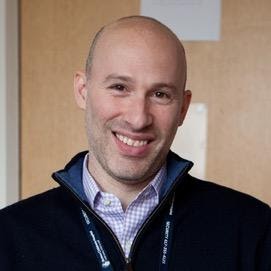
Michael is the co-founder and CEO of Dock Health. With over a decade of clinical practice and helping to build the culture of innovation at the preeminent children's hospital, Michael has been at the forefront of the design and implementation of health technology. From his work in the Innovation and Digital Health Accelerator to serving as faculty in Clinical Informatics, Michael has been a part of or led many cutting edge initiatives from implementing secure messaging, mobile EHR and voice enabling mobile technologies to developing a virtual reality platform for customizable patient education.
untoldcontent.com/trainings/innovation-storytelling-training
TRANSCRIPT – Healthcare Communication Solutions
This episode, Healthcare Communication Solutions is powered by Untold Content’s innovation storytelling training. Increase buy in for your best ideas in this immersive and interactive, story-driven experience. Where your teams refine storytelling techniques for their latest projects, prototypes and pitches—and get inspired by 25 epic examples of impactful innovation stories. Learn more at https://untoldcontent.com/innovationstorytellingtraining-2/.
Katie: Welcome to Untold Stories of Innovation, where we amplify untold stories of insight, impact and innovation. Powered by Untold Content, I’m your host, Katie Trauth Taylor. Our guest today is Michael Docktor. He is co-founder and CEO of Dock Health. He is also the former Clinical Director of Innovation at Boston Children’s Hospital, co-founder at Health Voyager and Hacking Pediatrics. Michael, thank you so much for being on the podcast today.
Michael: Thank you for having me.
Katie: So, first of all, how are you and your teams doing during the pandemic?
Michael: We’re doing well. Thank you. It’s, as you can imagine, a curious time for everyone. We are fortunate to be a remotely run business operating in the Cloud and super comfortable with Zoom. So it’s kind of business as usual in many respects for us. But we’re certainly in our growth phase. And it’s trying times for everyone. We feel very fortunate.
Katie: Yes, of course. Yes. And I would love to know, you know, what led you from the bedside to innovation and then, of course, the natural progression into having your own startups.
Michael: Yeah. Well, I don’t know how long this podcast is, but I’ll try and keep it short. You know, I’m a pediatric gastroenterologist at Boston Children’s Hospital and really have always been a technologist at heart and had an entrepreneurial spirit. And really throughout my times at Boston Children’s Hospital, certainly during my fellowship, I had a bunch of downtime. And it was around the time of the birth of the app store. And I became enamored with helping to build apps and built a few, didn’t actually do the coding, but worked with folks that could. And got really into design and user experience and really began to appreciate the opportunities of mobile devices and their implications in healthcare. And at the time, amazingly, no one was really thinking about those opportunities at, you know, arguably the world’s best children’s hospital. So I kind of stepped into that role and became a thorn in the side of our CIO and CMIO and said, you know, we need to be thinking about more mobile tools. And I helped usher in the first secure messaging vendor at Boston Children’s Hospital and changed the way we can communicate at the hospital. And that’s sort of, you know, it was the beginning of my entree into mobile technologies and the opportunities in healthcare. And along the way, as you mentioned, you know, co-founded a group called Hacking Pediatrics, which really brought engineers, designers and entrepreneurs together to help build solutions for pediatrics and healthcare in general. And so just got tons of exposure to startups and entrepreneurship and all the exciting things about the startup ecosystem and helped to build our innovation program as the Clinical Director there. And I wanted to throw my own hat in the ring as I had plenty of ideas and had the good fortune of meeting my co-founder, who’s a user experience designer. And the rest is history.
Katie: And that’s a pretty powerful combination right there. I love that one of the first really big innovation initiatives that you took on was a communications or messaging app among providers in the hospital. Can you tell us more about that? I know personally, because of a lot of our work at Untold focusing on medical storytelling, that provider communication is such a major challenge. And when it’s inefficient or when people aren’t able to do that in a way that’s coordinated really well, it really increases the risk of there being safety problems or just inefficiencies as well. And it’s really just a burden to the system. So what inspired you to tackle provider communication?
Michael: Well, as you know, and I’ve already suggested, you know, communication is everything. And getting the team on the same page in whatever fashion is essential to good patient care and frankly, good provider care. The dawn of kind of secure messaging was, you know, early 2012, 2013. And I — we all had familiarity with text messaging on our smartphones. And I was amazed at the fact that we weren’t using that technology in healthcare. And so I looked at the marketplace and saw there a couple of vendors that had begun to tiptoe into that space. And I was fortunate to meet the folks at Tiger Text, which was sort of the first and biggest secure messaging vendor. And we became their first large academic medical center client. I since went on to develop a great relationship with that team and was an adviser to them for a while. But we — you know, that was sort of my pet project at Boston Children’s and we implemented that in 2013. There’s a story behind that which is interesting if we have time. But suffice to say that it was a really valuable tool that ushered in sort of a new, better way to communicate as teams and tried to move away from this sort of de facto communication tools of pagers and things that are kind of one way, really, frankly, painful ways to communicate.
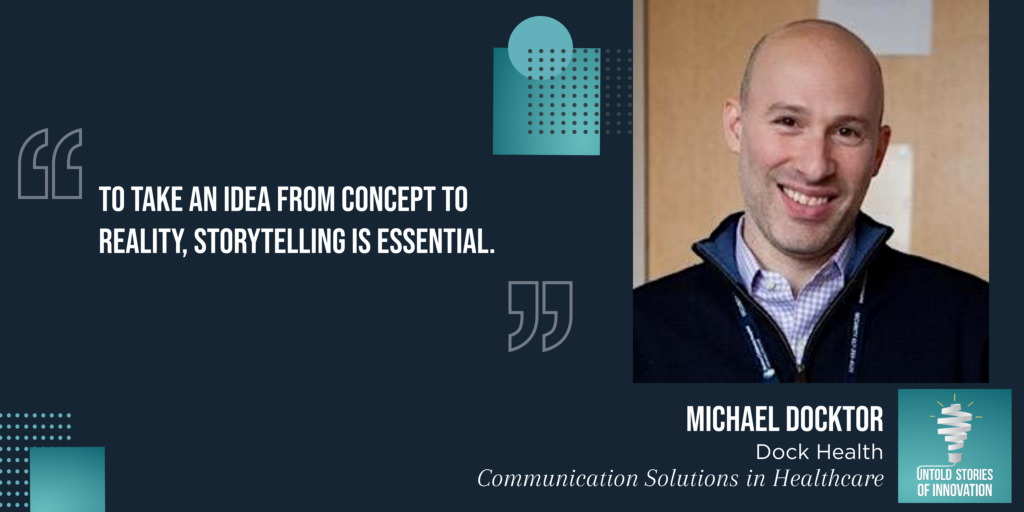
Katie: Well, you’ve hooked us with an opening to another story. I can’t hardly not take the bait. Is there a way to tell it briefly?
Michael: Yeah, I’ll do my best.
Katie: OK.
Michael: So the short version is that we had, you know, as a sort of project lead, we had a thoughtful plan to roll out this really disruptive — hopefully in a good way — disruptive tool to the masses at Boston Children’s Hospital. And we had a small pilot group of about 30 users that, you know, were testing out the technology and seeing what worked, what didn’t work, chiming, you know, Wi-Fi dead zones and that sort of thing. And then something that kind of hit the radar quite significantly was that there was an anonymous attack on the network at Boston Children’s Hospital related to a patient issue that was national news. But at the moment there was a sudden loss of all of our connectivity at the hospital and so we had no real good way to communicate. And very quickly, we realized that we had an opportunity to roll out this tool, which we had, again, thoughtful plans for a slow sort of implementation. And we said, OK, let’s hit this and go live. And we went from 30 users to 800 users in about an hour. That was trial by fire. But it was a great way to implement a communication tool and proved to be a very valuable tool, at the time and beyond that.
Katie: Oh, wow. OK. Take us into the situation room. And truly, the storytelling that had to happen in that moment for that decision to go green light.
Michael: Gosh, yeah. I mean, it was literally there was a Situation Room and, you know, all those sort of players, you know, Chief Information Officer, Chief Medical Information Officer, Chief Nursing Officer. And we were faced with a really, really significant problem in a major academic medical center of, you know, how do we communicate? If I recall correctly, our e-mail was down, our Wi-Fi system was down, our pager system may or may not have been working. So really, our essential communication tools were down and we were trying to figure out what was going on, frankly. And, you know, we have this new tool that was, you know, potentially deployable to people’s personal devices and had the redundancy of Wi-Fi and cellular connectivity. So it was a kind of way around. And yet again, we had done months of planning and thought around the implementation of this, but just made the decision in the moment that this feels like risk and benefit. The benefit far outweighs the risk. And we’ve already been thoughtful about how to do this right. So let’s get the word out that this is the tool. So I think we put the message up on the internal intranet and messaged to as many of the providers as we can through whatever channels we had that we’re going to go live. And again, in that afternoon, we went from 30 to 800 or so users very quickly. And that proved to be a great tool in the moment and have durability beyond that.
Katie: Yes, absolutely. And so obviously the urgency led to the decision making, but also the credibility that had already been established amongst your team and the rest of the leadership to move that forward so quickly. Tell us how those formative experiences led you to develop and co-found Dock Health.
Michael: Well, you know, I think that there are a couple of factors that obviously, in retrospect, seem perfectly clear. But, you know, I learned a lot from the Tiger Text experience in that it was a very consumer-like experience and it was something that I think is sadly missing in healthcare. And so, you know, to have a consumer-like, tool-like secure messaging and the ability to sort of deploy it in a really well-designed, user friendly experience in a mobile tool was something that was really compelling to me. So that’s stock number one. Number two, just, you know, with my role in clinical informatics and sort of seeing what the electronic health record is like and all that sort of good and bad elements of it. I saw this unique opportunity that there was really nothing to help with managing tasks as a team. And I had the benefit of working in innovation in other industries that really were transformed by these tools of collaboration and project or task management. So things like Jira, Trello, Base Camp, Asana, and Wonder List in my personal life. These are all wonderfully successful and powerful tools that really transform how I dealt with my shopping list at home with my life, as well as our sort of software project management and thought, gosh, you know, how is this not available in healthcare to help people get coordinated with their efforts to help manage patient care, to help manage on the to dos of, you know, my clinical practice. And so we sought out to build just that.
Katie: And the big hoop, of course, that you had to jump through was HIPAA compliance, as you’re trying to create a project management software specifically for healthcare providers, right?
Michael: Yeah, yeah. So we were fortunate to be born and raised at Boston Children’s Hospital. And our Innovation and Digital Health Accelerator, so my co-founder, technical co-founder, CTO is the former lead engineer of the innovation program. And so he had, you know, the wonderful skill set of knowing full well how to build HIPAA compliant tools within an enterprise healthcare environment. So that was foundational to our development, was really being HIPAA compliant at our core, from the foundation, not kind of putting a HIPAA wrapper on something that already exists. But beyond that, we also, you know, wanted to spend a lot of time bringing in the sort of clinical and administrative elements of real practice that make Dock Health not just HIPAA compliant, but also really specifically built for healthcare. The nuances and workflows that are part and parcel of healthcare.
Katie: Absolutely. You know, it’s something that I really respect about Dock Health is the story, I would call it. Of course, you have a strong go to market strategy, but you also have a strong go to market story, if you will. And it sort of centers around provider burnout, especially with regard to administrative tasks. We recently did actually create a study around provider satisfaction and burnout. And we studied a lot of the validated tools to measure it. And your organization is absolutely right that administrative overload is a huge reason for burnout. And also, you know, lack of coordination or lack of communication and connection with your healthcare team is another contributor.
Michael: Yeah. You hit the nail on the head. I mean, this is — you know, it was really my own experience as a pediatric gastroenterologist and really struggling with all of this sort of, you know, to views that come as part of taking good care of your patients. And that’s the sort of stuff that would weigh on me as a provider, especially when things fell through the cracks. You know, when I forgot to do something because it was one of 20 tasks and then just simply had no good system to capture them or delegate them or track them. And so, again, it was that epiphany of like, I can track what my wife gets at the supermarket on an app. Like I should be able to do that for patient care.
Katie: Absolutely.
Michael: And again, fortunately, had Keather Roemhildt, my co-founder, who is a great user experience designer, helped build us a system that basically allows us to do just that in healthcare. And so, you know, for me, I often tell the story like the Friday afternoon — before Dock Health — I would leave the hospital feeling really stressed that I was going to forget something, that all the sort of little to dos that stacked up over the course of a week would somehow one or two of them would be forgotten or missed. And I’d end up hearing about some patient that ends up in the emergency room or some parent or colleague that’s angry because I forgot to do something. And post Dock Health, in my own practice, I had sort of that clarity of knowing what tasks need to be done, who is responsible for them, and I could honestly leave the hospital feeling much more relief. And that sort of stress and weight on my shoulders on a Friday afternoon was gone, which is a powerful feeling that I really want to help other folks, you know, feel the same experience.
Katie: Yes, I am grateful to hear your sort of personal passion and mission behind the company. And I think that’s a really critical part of innovation stories that resonate, is to be able to understand the founders and what inspired them to do this work. And so, you know, hearing about your personal practice and how it changed as a result of this is — that’s powerful stuff. Could you tell us some more of the innovation stories coming out of Dock Health or — actually, I’d broaden it, too, to any of your innovation work because you touched so many different spaces. So, you know, what other innovation stories or storytelling strategies do you find yourself leaning in on and you find being effective for getting buy in or funding or customers?
Michael: Yeah, there’s a lot there. You know, I guess there’s sort of some resounding sort of messages. You know, as a clinical director of innovation, I tried to help many a hopeful entrepreneur or many a provider or clinician or researcher to try and take their ideas from concept to reality. And I think, as you pointed out, the storytelling is essential. The ability to communicate clearly what is the problem you’re trying to solve. And I think having come out of an innovation program, you know, embedded within Children’s Hospital, you see many issues that people are looking to solve. And, you know, we spent the early days of the innovation program trying to build solutions to research projects or things that people perceive those as real problems. And we found that although we helped dole out some of these solutions, that they weren’t sustainable business ventures. And so they often died on the vine. And so, you know, in sort of version two of our innovation program, we really sought to not only help providers take their ideas and sort of take them to the next level, but really focus on the ones that had some commercial opportunity and the potential for sustainability. And so Dock was kind of one of the early sort of second phase of innovations. And it was clearly a passion project of mine. And we spent lots of time validating it and refining it and using this sort of wonderful test of Boston Children’s Hospital. And then validating it externally. And so we found that there were people willing to pay for this solution that we had built. And ultimately, it became something that was worth actually going to talk to venture capitalists about, really spinning out of company and putting some real funding behind it to move it to the next level. And so, you know, it’s a process. And I think sourcing problems at the rock face and really trying to solve real clinical problems, not — you know, there’s nothing worse than seeing, you know, these brilliant technical solutions to problems that don’t actually exist. So, again, having come from a clinical program, seeing real problems that clinicians and parents and providers and administrator folks are facing and actually trying to solve them, I think is a powerful process to be part of.
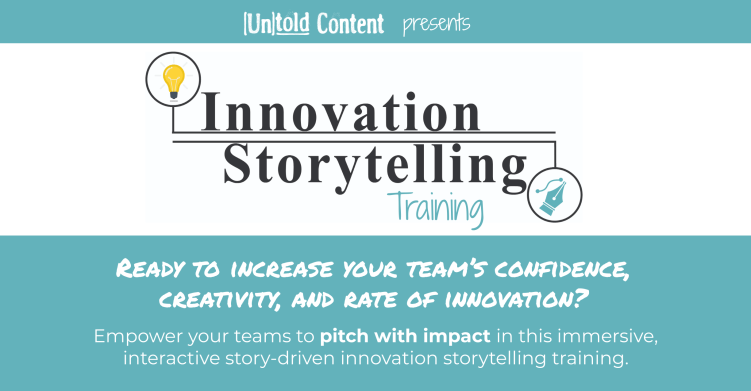
Katie: It sounds like, of course, you had personal experience with this problem of having so many items on the to do list, so much administrative work. But it sounds like your organization overall also was constantly listening to the voice of your consumer, right, to the voices of providers and care teams who were burdened with this and trying to — it sounds like you were able to spark quite a bit of momentum based on that shared understanding of, all this work really leads to burnout so fast.
Michael: Yeah, it’s interesting. I’ll tell you, the electronic health records get all the blame for burnout. And this is part of my personal mission is really trying to, you know, not to defend them, but to kind of refocus the blame on, you know, the sort of moral injury that doctors and others talk about. You know, the challenge is just simply not having the right tools to help do our best work. And for me, it was really just dealing with all the sort of to dos that come as part of good clinical care that, you know, I want a better way to communicate with my team, to take good care of my patients. And electronic health records, you know, their forms of communication are e-mail inboxes that are, you know, of these silos. The e-mail inbox I had 20 years ago. And so, you know, again, bringing in things like secure messaging and bringing in things like secure task management and ways for people to collaborate and communicate in a modern consumer like way are things that I think we all need. And again, I think the EMRs just get all the blame for all the burnout. But the reality is that it’s the lack of the systems. You know, we use Post-it notes and e-mail to do the things that Dock Health is trying to replace. So anyway, I think it’s just really supporting the providers with the right tools for the right job.
Katie: Sure, sure. Can you tell us, too, about culture change inside of an industry like healthcare where it’s a high reliability industry, you know, safety is always the number one concern. And therefore, it can be one of — a vertical where, you know, change can come a little bit more slowly, typically. How do you — have you noticed certain cultural or systematic, you know, changes that have needed to happen in order for certain technologies and certain new platforms to be accepted and implemented well?
Michael: Yeah, that’s a great question. And yes, there’s so much to that. I would say certainly change management is likely difficult in all industries. I feel it particularly challenging —
Katie: Yes, that’s fair.
Michael: Particularly challenging in healthcare because of the entrenched sort of workflows and incumbent systems like a, you know, an electronic health record and e-mail, for example, or Post-it notes. But so I think people — my experience, you know, having worked in innovation and obviously in healthcare, you know, the sort of clinical enterprise and the administrative and clinical components of that, people are very loathe to change. And so, you know, I guess like any innovation, there are the early adopters. And I think finding those early adopters and clinical champions to help kind of really carry your platform forward within a group is always essential. And so part of — again, just harkening back to my experience with Tiger Text and secure messaging — I was that early adopter clinical champion that helped ultimately get Tiger Text into Boston Children’s Hospital. And, you know, the rest of that is history. But, you know, we’re kind of taking a similar tact in that, you know, we want to find clinical champions, early adopters that are going to help bring what I think is a really transformative tool into their clinical practice. And it may start in small groups, you know, in a small clinical practice within a large enterprise, or simply a small practice that is a little bit more nimble than an enterprise. But finding those clinical champions and that sort of early adopters and that grassroots effort, you know, we’ve really intended to try and make it as easy for those folks as possible to get on board. We’ve made our app entirely self service so they can sign a B.A. right through the app. And, again, tried to make it really easy in consumer life. So that minimized the barrier to entry.
Katie: Absolutely.
Michael: But, you know, ultimately selling into the enterprise and all this sort of death by committee that may occur, there is challenging. And we’re going to have to face that in the coming months and years as we grow.
Katie: Sure. Yes, of course. And I think that that’s a natural moment of growth for any startup. Especially rapid growth, one like Dock Health. So I would love — you know, looking back on your years in innovation as a startup founder now, could you share some advice before we wrap up our conversation, especially advice around how to communicate your innovation well and get buy in?
Michael: Well, that’s — again, you ask good questions.
Katie: You have great answers.
Michael: Well, thanks. I don’t know if this one is going to count, but we’ll see. To your point, it is about storytelling. And I think, you know, my own experience has been a journey in that, you know, when I first started using PowerPoint slides, you know, many years ago, I had everything I wanted to say on the slide. I learned over time that the less you have in the slide, the better. So the more that you can show a picture, but tell a story that your users can connect with. I think the same is true of any, you know, any sort of presentation, whether it’s verbal or, you know, slide form. It’s telling a compelling story. You know, for me, with Dock, it’s about telling users — whether it’s an investor or a potential user — telling them my story that Friday afternoon story or that sort of potential use cases. Putting it in their context. So when we talk to a prospective client, you know, if it’s a mental health practice, for example, we talk about the mental health use cases of Dock Health, and we put ourselves in their shoes and do our best to kind of communicate a story that is relevant to them. And so I think that is one of the powers or benefits that we have is that we’ve got a clinician founded company that has a basis in the medicine and the sort of communities we’re trying to sell to, so that we can tell a compelling and realistic story of, here’s the issues that you might be having, here’s how we can help solve them. So I think it’s — again, as we started off with — starting to tell compelling stories that matter to the recipient, to the listener. And being honest and transparent about, you know, not trying to be a salesman, but just telling something that I am passionate about. That goes a long way.
Katie: Yes, absolutely. I couldn’t agree more. And I think the thing I’ll take away from our whole conversation is just that deep understanding of your audience, your consumer, the people who you’re trying to help solve a problem with or for. You know, your understanding of their experiences will be the make or break knowledge that will determine your success. And if you can tell that story of the problem back to them in a way that’s clear and relatable and compelling to them, then you’ve really — that’s such a key to making that solution be viable in their minds. And so — Well, I am so grateful for the time that we’ve had together. I also just have to ask one last question, Michael, which is, your last name is spelled D-O-C-K-T-O-R. Did you just feel as though you needed to be a doctor when you were a child?
Michael: You know, there was kind of no choice in the matter, as you might imagine. No, I didn’t. My parents told me that from the earliest ages, I was drawn to science and always wanted to be a doctor. Now, I can’t imagine that my name didn’t have something to do with it. We do have video evidence of me at a birthday party when I was five years old, saying that I wanted to be a doctor when I grew up. So —
Katie: That’s very sweet.
Michael: It is something that I’m very proud to have been part of my world and certainly try to now have a new sort of venture in entrepreneurship. Now, my name probably played a role. And what a good icebreaker.
Katie: I love that image of you as a five year old saying that. So thank you for sharing that. I’ve been curious about that during the entire conversation. So, Michael, thank you so much. Thank you for the — to the Dock Health team for making time to be on the podcast and be featured today. And you can follow Michael at Michael Docktor on Twitter and Instagram and you can follow Dock Health at D-O-C-K Health. Thank you so much again for joining us.
Michael: Thank you.
Katie: Thanks for listening to this week’s episode. Be sure to follow us on social media and add your voice to the conversation. You can find us at Untold Content.
You can listen to more episodes of Untold Stories of Innovation Podcast.
*Interviews are not endorsements of individuals or businesses.
